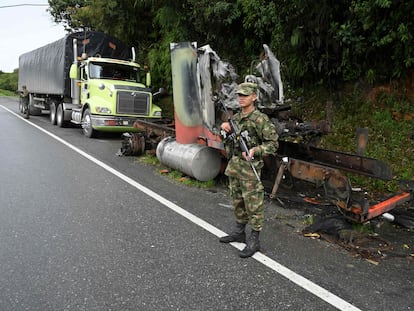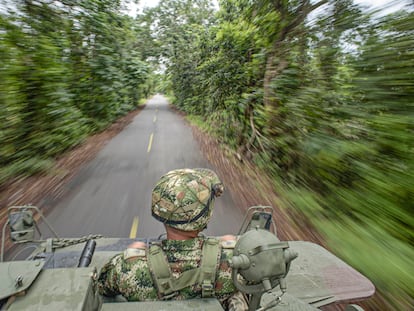Picking coca leaves in Colombia: The thankless job that Venezuelans are doing
Up to 13,000 migrants are working in Tibú, attracted by a job that pays relatively well. But opportunities are drying up as sales of coca paste grind nearly to a halt
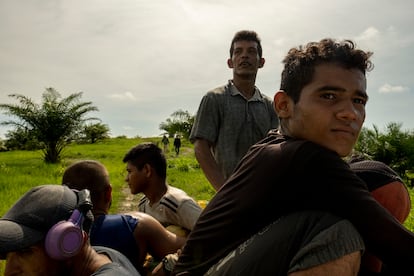

The sound that the coca leaves make as they are picked is interspersed with a Bad Bunny song. One of the nearly 20 workers at this plantation located between Tibú and La Gabarra, in the Colombian department of Norte de Santander, is listening to the music on purple headphones, but the muffled sounds can still be heard a few feet away, where the oldest picker is standing. He is 63 years old and he arrived here from Venezuela four years ago with his wife, who is Colombian and herself lived in the neighboring country for four decades. Back in Venezuela, this man used to work as a supervisor in oil companies, and sometimes chauffeured people around. He still has his house in Venezuela. But for the last four years, he has been picking coca in the fields of Colombia. “There is nothing else to do,” he says.

He answers questions without stopping his work. Every second spent without picking a few extra leaves is wasted time. The raspachines, as they are often called, are paid 1,000 Colombian pesos per kilo of coca leaf (22 cents). He figures he makes about 40,000 pesos on any given day, but there are others who are faster and can earn up to 80,000 or 100,00 pesos (almost $22) per day.
At 9am workers take what they have picked to the cambuche, a kind of ranch about 15 minutes away on foot, where employees weigh the bundles. Later, the leaves will be mixed and processed with kerosene, sulfuric acid and other elements to create coca paste, used by drug traffickers to produce cocaine. “Twenty-five kilos,” writes the cambuchero in a notebook. The routine can be repeated two or three times a day: pick leaves, go to the shack, weigh the leaves and pick again. Pay day is on weekends.
Tibú, the municipality in Colombia with the largest number of coca crops at 19,333 hectares, has also been a destination for migrants from Venezuela in recent years. “At least 8,000 Venezuelans are registered here, but it is estimated that there are more than 13,000 in the municipality, and that some 25,000 have passed through here,” says Nelson Leal López, the mayor of Tibú. For this municipality, the recent opening of the border with Venezuela has been more of a symbolic issue. While it was closed, the migrants were still coming and going through the 32 illegal trails that exist only in Tibú. “The migrant population increased in two specific years, in 2018 and 2019, when the percentage rose from 14% to 22% in rural and urban areas,” explains Kenny Sanguino Cuéllar, a research professor at the Universidad Libre Seccional Cúcuta.
Picking coca, despite being hard work, became an opportunity. “Coca cultivation has supported the migrants, because the grower has to pay the worker whether or not he has the money,” says Teoniro Vargas, a member of the Catatumbo Peasant Association (Ascamcat) and president of the Peasant Movement of Coca, Poppy and Marijuana Growers (Coccam) of the municipality of El Zulio. Professor Sanguino agrees that migrants often arrive in conditions of vulnerability and are tempted by the job opportunity of working as pickers on coca plantations. Meanwhile, “the migrants support the growers because the local people no longer want to work in this.”
Life on the margins
Eight years ago, when Jennifer, who prefers not to share her surname, was still living in Santa Bárbara del Zulia (Venezuela), she was told that in Colombia she could do two things: pick coca or work at Mango de la Negra, a brothel in the area. She knew she was never going to accept the second proposition. “I ended up moving in those circles, but as a bartender, selling beer,” she recalls. “But that’s tough. If a drunk man gets out of hand, and you are a woman…”, she says, leaving the sentence unfinished. The least a waitress can expect is to get a slap on the bottom as she passes by.
Scholars such as Julia Zelver and Annette Idler have found that experiences of gender insecurity are reinforced in border towns. And in the case of Norte de Santander and Venezuela, the humanitarian crisis together with the constant reconfiguration of armed groups increases women’s exposure to different types of violence, including sexual violence. For this reason, when Jennifer met her current husband, who is also from Venezuela and has been in Colombia for eight years, she chose to go pick coca with him. At least in the plantations they treat her as an equal.

Jennifer does not pick leaves all day. In the morning she also brings sandwiches and soft drinks that he sells to the other workers. Sometimes, when there is no money circulating in Tibú, instead of getting paid in cash she gets the money equivalent of two kilos of coca – 2,000 pesos – added to her account. When that happens, she makes sure to get to the cambuche first so that those extra kilos of coca are recorded under her or her husband’s name in the cambuchero’s notebook: that way they will be paid during the weekend.
At 11am, after many workers have already taken their first load to the cambuche, Jennifer goes home to a a village about 12 minutes walking distance from the plantation. “I start to make lunch and see how my girls are doing.” One of the children is seven years old and the other one is three.
The house is made of wood and is part of one of the many informal settlements that have grown along the road to La Gabarra. “I could have a bigger plastic house, but I don’t feel safe,” says Jennifer. The water is obtained from an underground well and the electricity from the neighbor. Because these are informal settlements, explains Leal from the Tibú Mayor’s Office, they cannot be offered any type of public service.
The settlements are not the only pressure that migration has brought on Tibú. “We can’t guarantee them health services either,” says the mayor, explaining that Tibú is a municipality that only receives around 100 million Colombian pesos from the state and almost 54 million goes to subsidize the health of those who cannot pay for it. From the coca crops, the 63-year-old picker repeats the same thing: “They haven’t given us a single thing for the pain.”
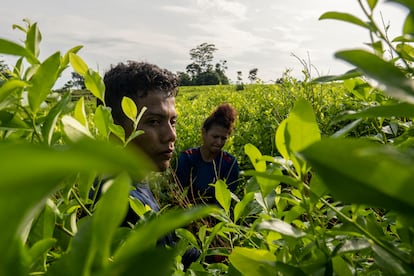
The hands of coca pickers are often bruised and callused, despite the gloves and cloth bandages that they usually wear. They also suffer pain in the lower back from bending down to forcefully grab the coca leaves that are at the bottom of the stem. They are also exposed to diseases spread by mosquitoes and other insects and can become dehydrated. “This work is tough. It even burns your hair. It wasn’t this color. It’s already yellowish, ”says Jennifer about herself. At the age of 23, she has been told that she already has incipient arthritis in her hands.
The United Nations High Commissioner for Refugees has warned that Venezuelan migrants and their families are at risk of coming to harm. Victimization and exploitation are widespread in border regions. Bandits and roving paramilitary groups recruit Venezuelan youths and young adults (ages 13-25) into gangs. Armed actors coerce undocumented immigrants to work in coca fields or illegal gold mines, and Venezuelan women have been forced into sex work, warned an article published in the medical journal The Lancet.
Added to this layer of vulnerabilities is one more: for six months there has been a lull in coca paste sales, which has reduced jobs for raspachines and made everything more expensive in the municipality. “There is a decline in morale in the migrant population. Many have looked for another destination or have returned to Venezuela to look for work. Twenty days ago, several workers left here for other countries, because the sale of the product has been very low and everyone is looking for a way to make ends meet,” explains César Ruiz, president of the Campo Raya district board.
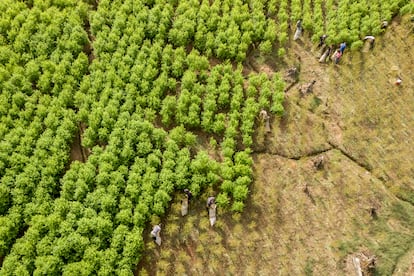
In Jennifer’s house, some people are talking about the Venezuelans who lived in Tibú and who recently headed for the United States through the Darién jungle crossing. They got together between four and five million Colombian pesos (between $874 and a little over $1,000) and were on their way, although nobody knows if they made it. “My husband and I talked it over and we would do it if we didn’t have the girls. But not with them. Whatever they may say about us, we haven’t let them starve here,” says Jennifer. The family has also thought about going to Santa Marta, on Colombia’s Caribbean coast, where her husband could work as a bricklayer. For now, however, their plan is to have their own small coca crop at home, at the foot of the mountain. They already have a local license to grow it themselves. “It takes about four months to harvest the coca, so if we plant it now, we would have it by January. The idea is to have a product when no one else has.” The plan could work, as long as coca paste sales, paralyzed for months, are reactivated in Tibú.
Tu suscripción se está usando en otro dispositivo
¿Quieres añadir otro usuario a tu suscripción?
Si continúas leyendo en este dispositivo, no se podrá leer en el otro.
FlechaTu suscripción se está usando en otro dispositivo y solo puedes acceder a EL PAÍS desde un dispositivo a la vez.
Si quieres compartir tu cuenta, cambia tu suscripción a la modalidad Premium, así podrás añadir otro usuario. Cada uno accederá con su propia cuenta de email, lo que os permitirá personalizar vuestra experiencia en EL PAÍS.
¿Tienes una suscripción de empresa? Accede aquí para contratar más cuentas.
En el caso de no saber quién está usando tu cuenta, te recomendamos cambiar tu contraseña aquí.
Si decides continuar compartiendo tu cuenta, este mensaje se mostrará en tu dispositivo y en el de la otra persona que está usando tu cuenta de forma indefinida, afectando a tu experiencia de lectura. Puedes consultar aquí los términos y condiciones de la suscripción digital.
